[EN/PL] Dark Deeps, Immersive Voids. ‘Life Begins after Fifty, Although It Ends at Forty” at the Municipal Gallery bwa in Bydgoszcz
![[EN/PL] Dark Deeps, Immersive Voids. ‘Life Begins after Fifty, Although It Ends at Forty” at the Municipal Gallery bwa in Bydgoszcz](https://blokmagazine.com/wp-content/uploads/2021/08/slezkin-de-smet-widok-wystawy-fot-tomasz-zielinski-img-0407-1200x800.jpg)
[EN]
Dark Deeps, Immersive Voids
If we are to trust the words of Michel Huellebecq from his novel The Possibility of an Island, both painters have been through the end of life and are now truly living it again. The artists as well as their main working medium have survived their end and made it out alive. Maybe the resultant similarity makes Slezkin and De Smet use painting so accurately, treating the canvas both as a field of autonomous and universal expression and an instrument of analysis of the world and its symbols, which carries a rich history.
What can we infer from the first part of the exhibition’s title? Is life after fifty still worth living? Thankfully the artists don’t give any answers, affecting the viewer with a diversified visual language and putting them in a state of disorientation.
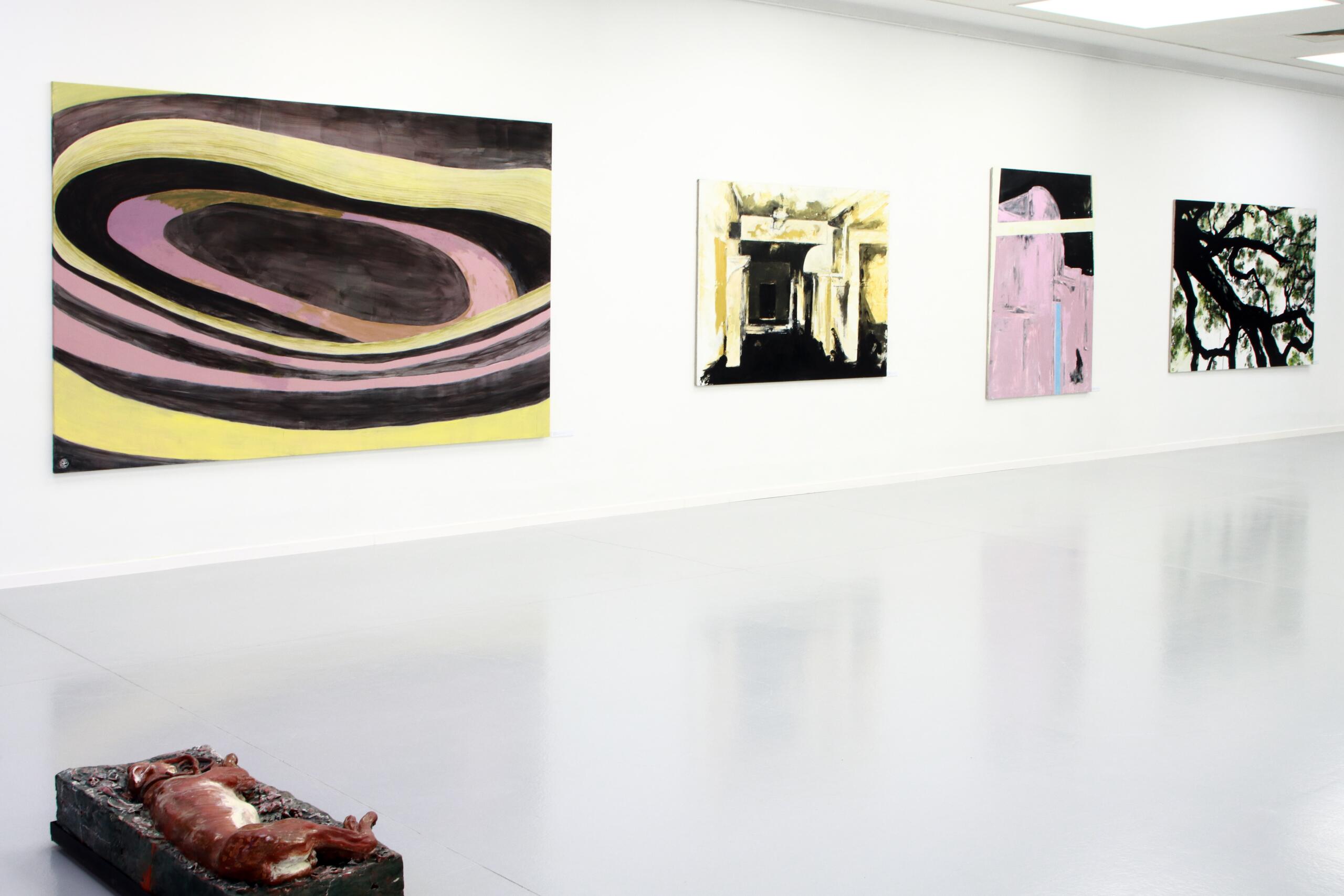
SLEZKIN / DE SMET, ‘Life begins at fifty, although it ends at forty’, exhibition view, photo: Tomasz Zieliński, BWA Bydgoszcz
My own confusion was additionally intensified by a situation that took place before going to the second floor, where the exhibition was held. I visited the gallery with my four-year-old son Staś and while viewing the exposition on the first floor we were approached by a staff member of the gallery, who suggested to skip the first floor due to pornographic images. Automatically I imagined a gallery space filled with large-scale frames from porn movies. Most likely that would be the only type of representation which I could actually omit because of my child. Going up the stairs, I felt curious and a little anxious. When we reached the somewhat forbidden second floor, these feelings were joined by surprise and maybe even a little disappointment. Not only was there none, not even the slightest bit of nudity, but also Staś walked into the exhibition with interest and quickly found the work that attracted him the most – a ceramic sculpture “Beloved” by Slezkin from the cycle “I dreamed of”. Intrigued, he asked me about the lying dog: is it asleep or dead? I didn’t have any answer and it was just the beginning. Other questions which appeared only in my head while looking at the exhibition also remained without an explanation. I found myself in a mysterious „in between” zone, which didn’t show me any specific way to take. I tried to find some schemes or familiar codes, but they kept slipping away. At an exhibition about life itself it’s the most accurate state one can wish for.
The exposition consists mostly of large-scale paintings. The works of both artists interchange with each other, which results in even more disorientation – before looking at the information under the painting, it is not easy to decide which of the two painters made it. This proves the accuracy in combining their work together by the curator.

SLEZKIN / DE SMET, ‘Life begins at fifty, although it ends at forty’, exhibition view, photo: Tomasz Zieliński, BWA Bydgoszcz
Slezkin and De Smet come from different countries, connected mostly by their age and profession. The similarity between some of their paintings leads to the assumption that their creative processes also have a lot in common. However, after taking a closer look, you can see the individual expression of each artist as well as their characteristic ways of analyzing culture codes, social and political phenomena. Michał Slezkin, a graduate of the graphics department of the Academy of Fine Arts in Warsaw, expresses himself mostly through painting and sculpture. In his works, he addresses the ideas of existentialism, referring to history, politics, and culture. Gery De Smet, who lives and works in Belgium, constructs also installations, uses words as the matter of his art, and produces works in public space. The sources of his inspiration come mostly from the outside, whereas Slezkin concentrates mostly on what comes from the inside – his feelings and dreams. It is impossible to place their art in any fixed frameworks – in both cases it slips away from specific classification. This is what makes them match so well in the gallery space.
The loudest voice in the silent conversation of paintings is black which appears in all of them and draws the viewer into empty corridors of insane asylums in the “Inner spaces” cycle by Slezkin and inside De Smet’s “Life on its own”. From this blackness slowly emerges a picture of life mentioned in the title, in which there is no place for innocent, childlike fantasies. The dog from „Beloved” lies still – in the spatial version there is a snake curling next to it. The Amazon River dolphin is immersed in thick, dark slime (Michał Slezkin, „So what?” 2019) and in De Smet’s work we find houses which didn’t live to see a new house built right next to them. Dark deeps and immersive voids merge together into an image of life free of vain hopes and expectations. This impression is stressed by the uneasy matter of paint which, suspended in one painting, crosses over to the next one to tell more stories. Continuity can be seen not only among each artist’s individual paintings, but they also run through one another. Slezkin’s dreamlike scenes and sharp abstractions are reflected in De Smet’s surreal spaces. They are also connected by the motif of disguised pornography – in the works of De Smet we find erotic scenes framed by symbols from the runic alphabet, whereas Slezkin hides them behind seemingly simple abstractions. In brief, the warning we were given in advance turned out to be pointless and the interest in the sculpture of the dog so strong that the naked bodies went unnoticed.
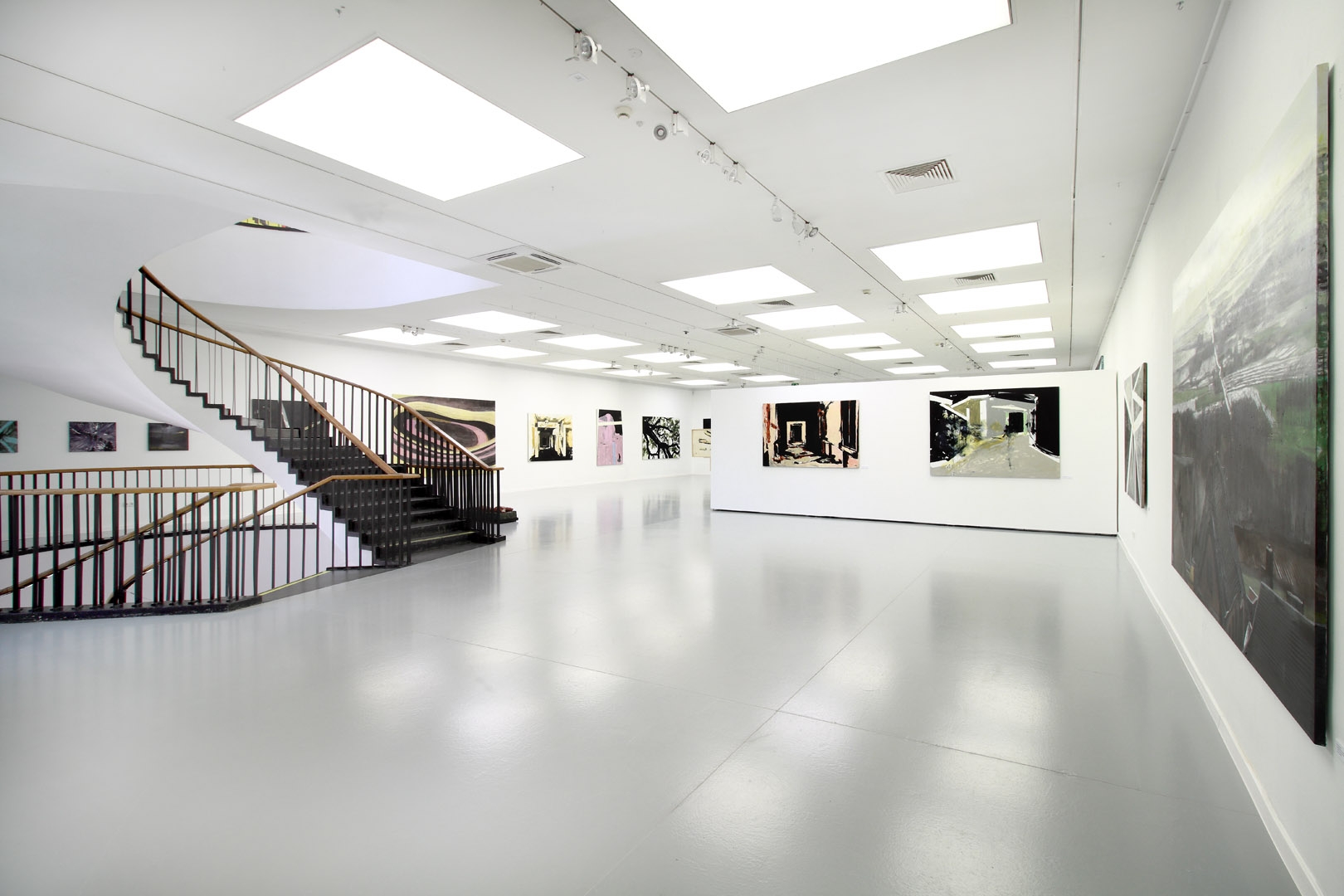
SLEZKIN / DE SMET, ‘Life begins at fifty, although it ends at forty’, exhibition view, photo: Tomasz Zieliński, BWA Bydgoszcz
Meanwhile what worries me – a young woman – is this form of representation as the only way of speaking about women in the whole exhibition. Is there no other way of portraying the female element in the life described by Slezkin and De Smet? While asking this question, I am not sure if I really want to know the answer.
However, the role of women in creating this exhibition is significant, maybe even crucial. Thanks to the curator, Jagna Domżalska, who stands behind the idea of connecting the art of Slezkin and De Smet as well as the arrangement of the exhibition, we have the chance to sink into the depths of the artists imaginations and experience the piercing atmosphere of their paintings.
I appreciate the level of disorientation that characterizes the exhibition which is both absorbing and repulsive. You can’t tell where to draw the line between what Slezkin actually dreamed of and what he wishes he dreamed but what turns out to be just the unforgiving reality. Most of De Smet’s works are rooted in the real world but without understanding the context they are stranger than some of his abstractions. The paintings of both artists come out of their internal struggle and an intense way of experiencing reality. This leads to an impression that the works look also inside me, pulling out my fears and anxieties.
In one of Slezkins paintings Prometheus appears and he is carrying fire, but in the times of big fires and the global warming do we really need it? Isn’t it better to hide in a small house among tree roots in the painting „An own house” by De Smet and by doing so not let the fears take over? There are neither good solutions nor answers to existential questions. Michał Slezkin and Gery De Smet are aware of that and this is what makes their paintings crawl under the spectator’s skin. It’s hard to get rid of them.

SLEZKIN / DE SMET, ‘Life begins at fifty, although it ends at forty’, exhibition view, photo: Tomasz Zieliński, BWA Bydgoszcz
[PL]
Ciemne głębie, wciągające pustki
Jeśli mamy zaufać słowom Michela Huellebecq’a z jego powieści „Możliwość wyspy”, to obaj twórcy przeszli już przez kres życia, a teraz znowu prawdziwie je przeżywają. Zarówno artyści, jak i główne medium ich wypowiedzi mają za sobą własny koniec i wyszli z niego cało. Być może wynikające z tego podobieństwo sprawia, że De Smet i Slezkin tak trafnie potrafią posługiwać się malarstwem, traktując płótno zarazem jako pole autonomicznej i uniwersalnej wypowiedzi i niosące za sobą bogatą historię narzędzie analizy świata i jego symboli.
Co można wywnioskować z pierwszej części tytułu wystawy? Czy życie po pięćdziesiątce nadal warte jest przeżywania? Na szczęście artyści nie dają żadnych odpowiedzi, oddziałując na widzów za pomocą zróżnicowanego języka wizualnego i wprawiając ich w stan dezorientacji.
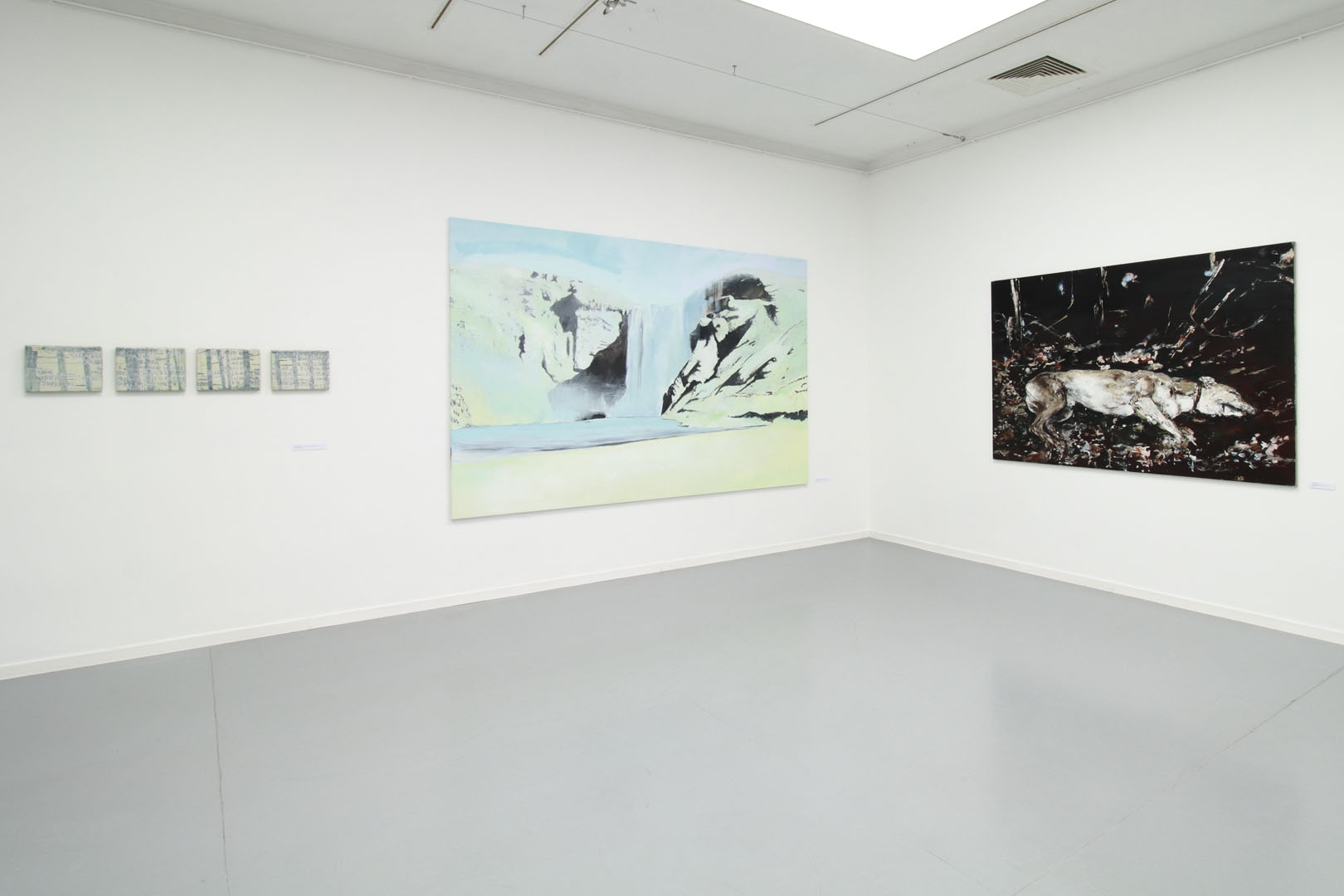
SLEZKIN / DE SMET, ‘Life begins at fifty, although it ends at forty’, exhibition view, photo: Tomasz Zieliński, BWA Bydgoszcz
Moje prywatne zagubienie zostało dodatkowo wzmocnione przez sytuację, jaka miała miejsce przed wejściem na pierwsze piętro, gdzie mieści się wystawa. Galerię odwiedziłam z moim czteroletnim synem Stasiem i jeszcze podczas oglądania ekspozycji na parterze podeszła do nas jedna z osób pracujących w galerii, sugerując pominięcie pierwszego piętra ze względu na przedstawienia pornograficzne. Automatycznie wyobraziłam sobie przestrzeń galeryjną wypełnioną po brzegi wielkoformatowymi kadrami z pornosów. Możliwe, że byłby to jedyny rodzaj przedstawienia, który mogłabym rzeczywiście pominąć z uwagi na dziecko. Wchodząc po schodach czułam ciekawość i lekki niepokój. Gdy dotarliśmy na poniekąd zakazane pierwsze piętro, do gamy uczuć dołączyło zaskoczenie, a może nawet niewielkie rozczarowanie. Nie dość, że na horyzoncie żadnej, choćby minimalnej nagości, to jeszcze Staś z zainteresowaniem wchodzi w przestrzeń wystawy i szybko odnajduje pracę, która pociąga go najbardziej – ceramiczną rzeźbę Slezkina pt. „Ukochany” z cyklu „Śniło mi się”. Zaciekawiony zadaje mi pytania o leżącego psa: śpi, czy umarł? Odpowiedzi nie mam, a to właściwie dopiero początek. Dalsze pytania, które pojawiają się już tylko w mojej głowie podczas oglądania wystawy, również pozostają bez odpowiedzi. Znajduję się w jakimś tajemniczym „pomiędzy”, które nie prowadzi mnie w żadną konkretną stronę. Staram się odnaleźć schematy, jakieś znane mi kody, ale wciąż mi się wymykają. Na wystawie o samym życiu jest to najtrafniejszy stan z możliwych.
Ekspozycja złożona jest w znacznym stopniu z prac wielkoformatowych, które wyraźnie dominują. Dzieła obu artystów przeplatają się nawzajem, co niekiedy skutkuje dodatkową dezorientacją – przed spojrzeniem na informację umieszczoną pod obrazem niełatwo jest od razu określić, który z malarzy jest autorem, co świadczy o trafnym zestawieniu ich twórczości przez kuratorkę.
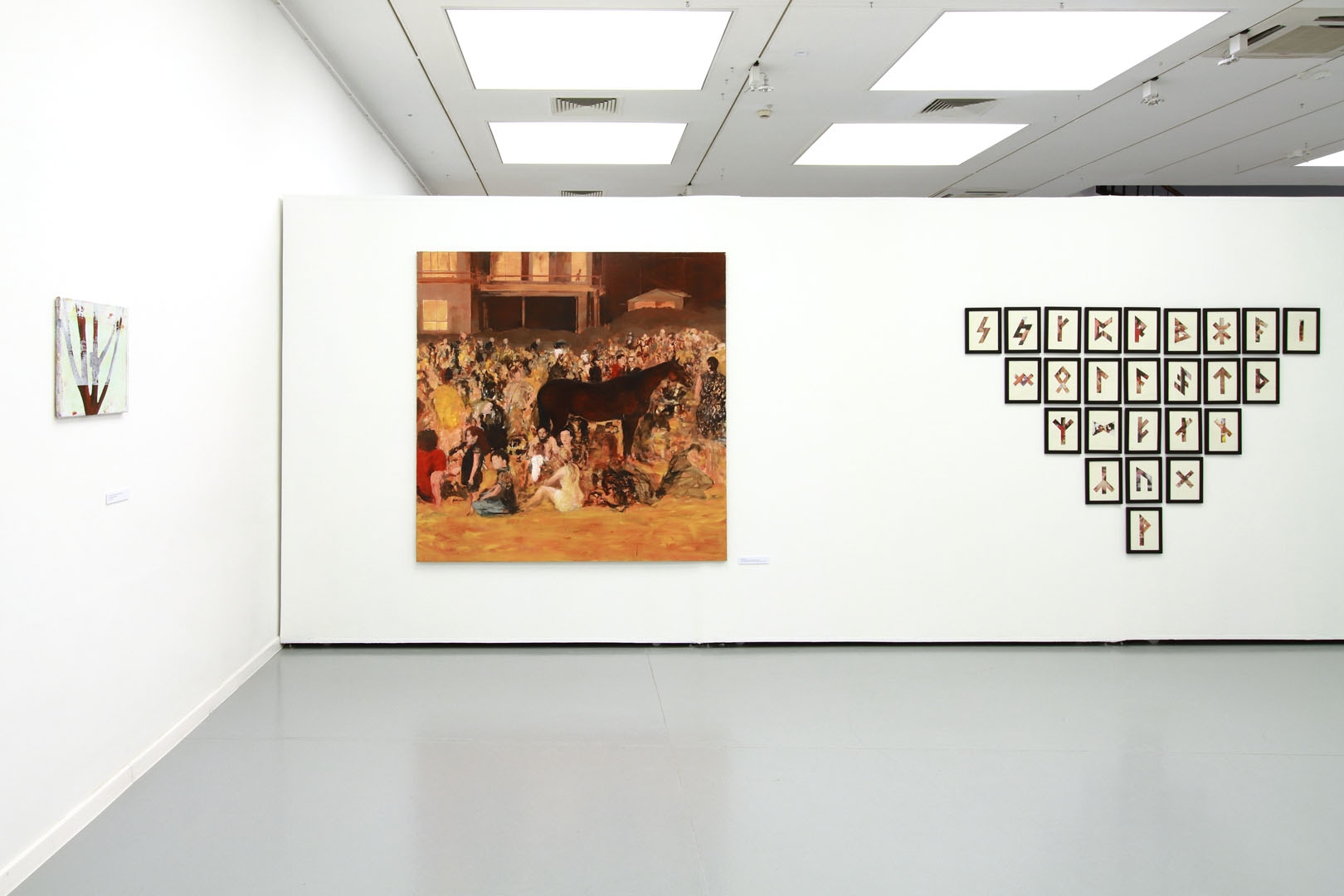
SLEZKIN / DE SMET, ‘Life begins at fifty, although it ends at forty’, exhibition view, photo: Tomasz Zieliński, BWA Bydgoszcz
Slezkin i De Smet to artyści z różnych krajów, których łączy głównie wiek i wykonywana profesja. Podobieństwo niektórych ich prac wskazuje, że ich procesy twórcze również mają ze sobą wiele wspólnego. Jednak po dokładniejszym zapoznaniu się z pracami na wystawie, u obydwu twórców widoczna jest ich indywidualna ekspresja oraz swoista analiza kodów kulturowych, zjawisk społecznych i politycznych. Michał Slezkin, absolwent grafiki na ASP w Warszawie, wypowiada się głównie poprzez malarstwo i rzeźbę. W swoich pracach porusza tematy egzystencjalne, odwołując się również do historii, kultury i polityki. Pochodzący z Belgii Gery De Smet poza malowaniem konstruuje również instalacje, używa jako materii swojej twórczości słowa, oraz realizuje prace w przestrzeni publicznej. Źródła jego inspiracji pochodzą głównie z zewnątrz, podczas gdy Slezkin koncentruje się w szczególności na tym, co pochodzi z jego wnętrza, przeżyć i snów. Nie sposób jednak wpisać twórczości każdego z nich w sztywne ramy – w obu przypadkach wymyka się ona konkretnym klasyfikacjom. To właśnie sprawia, że tak dobrze współgrają ze sobą w przestrzeni galerii.
Najdonośniejszym głosem w cichej rozmowie pomiędzy obrazami jest czerń, która pojawia się w każdym z nich i wciąga w puste korytarze domów dla obłąkanych w cyklu obrazów „Przestrzeń wewnętrzna” Slezkina i do środka obrazu De Smeta „Życie samo w sobie”. Z tej czerni wyłania się powoli obraz tytułowego życia, w którym nie ma miejsca na niewinne, dziecięce fantazjowanie. Pies z obrazu „Ukochany” leży nieruchomo, w wersji przestrzennej wije się obok niego wąż. Inia amazońska zanurzona jest w gęstej, ciemnozielonej mazi (Michał Slezkin „I co?”, 2019), a u De Smeta znajdujemy zapomniane ściany, które nie doczekały dobudowania do nich nowych domów. Ciemne głębie i wciągające pustki tworzą razem obraz życia pozbawionego zbędnych nadziei i oczekiwań. Wrażenie to podkreśla również niespokojna materia farby, która, zatrzymana w jednym obrazie, przechodzi zaraz na inne, żeby tworzyć kolejne historie. Ciągłość widać nie tylko pomiędzy obrazami każdego artystów z osobna, ale również przenikają się one nawzajem. Oniryczne sceny i ostre abstrakcje Slezkina znajdują odzwierciedlenie w surrealistycznych przestrzeniach De Smeta. Łączy je również motyw zakamuflowanej pornografii – u De Smeta znajdujemy sceny erotyczne oprawione w symbole alfabetu runicznego, natomiast Slezkin skrywa je za pozornie prostymi abstrakcjami. Słowem, ostrzeżenie pani z galerii okazuje się zbędne, a zainteresowanie rzeźbą psa tak silne, że nagie ciała nie zostają przez Stasia odnotowane.
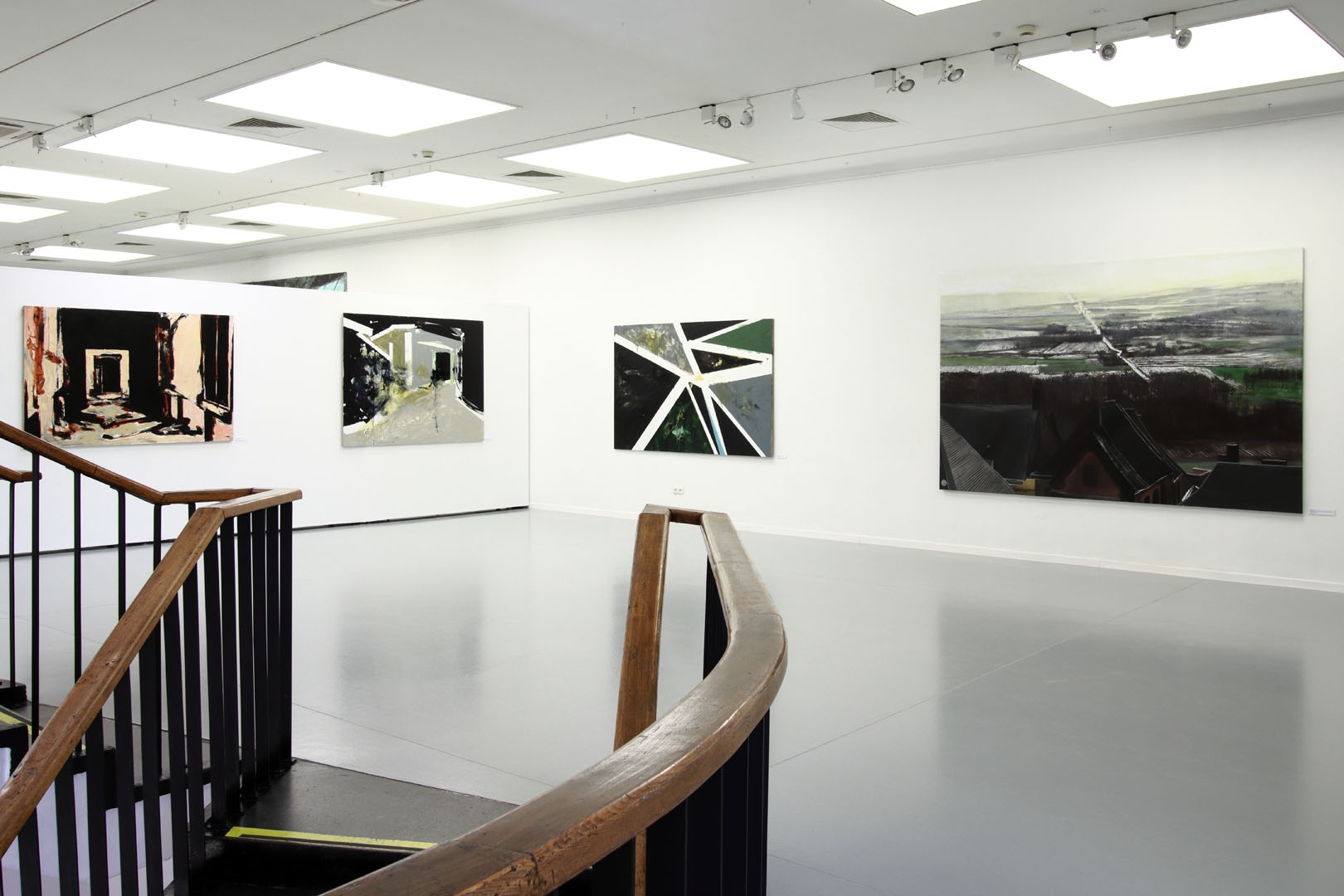
SLEZKIN / DE SMET, ‘Life begins at fifty, although it ends at forty’, exhibition view, photo: Tomasz Zieliński, BWA Bydgoszcz
Tymczasem mnie – młodą kobietę – niepokoi ta forma reprezentacji jako jedyny sposób mówienia o kobietach na całej wystawie. Czy w życiu opisywanym przez Slezkina i De Smeta nie ma innej możliwości przedstawienia pierwiastka żeńskiego? Zadając to pytanie waham się, czy chciałabym znać na nie odpowiedź.
Jednakże udział kobiet w powstaniu wystawy jest znaczący, a może nawet kluczowy. To dzięki kuratorce, Jagnie Domżalskiej, której autorskim projektem jest zestawienie twórczości Slezkina i De Smeta oraz aranżacja całej wystawy, mamy szansę zagłębić się w odmęty wyobraźni artystów i doświadczyć przenikliwej atmosfery ich malarstwa.
Doceniam poziom dezorientacji towarzyszący całej wystawie, która jest jednocześnie wciągająca i odpychająca. Nie wiadomo, gdzie postawić granicę pomiędzy tym, co naprawdę śniło się Slezkinowi i tym co chciałby, żeby mu się śniło, a co okazuje się jedynie bezlitosną rzeczywistością. Większość prac De Smeta zakorzeniona jest w realnym świecie, jednak bez znajomości kontekstu wydają się one bardziej obce niż niektóre jego abstrakcje. Życie jest motywem przewodnim, ale ludzie są gdzieś na jego peryferiach. Obrazy obu artystów wynikają z ich przeżyć wewnętrznych i intensywnego doświadczenia życia. Skutkuje to poczuciem, że zaglądają one także do mojego wnętrza, wyciągając z niego lęki i niepokoje.
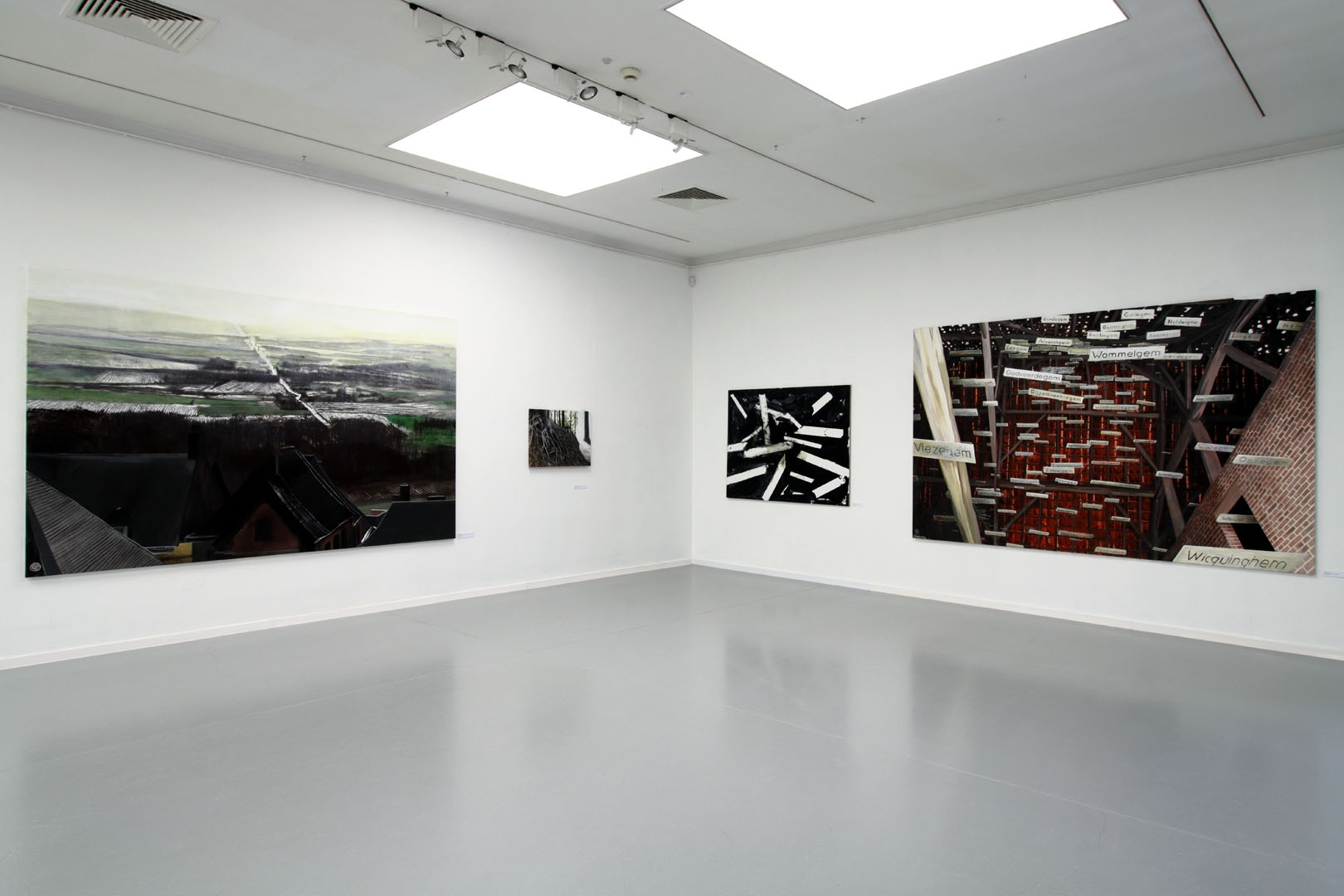
SLEZKIN / DE SMET, ‘Life begins at fifty, although it ends at forty’, exhibition view, photo: Tomasz Zieliński, BWA Bydgoszcz
Na jednym z obrazów Slezkina pojawia się Prometeusz niosący ogień, ale czy w czasach wielkich pożarów i podnoszącej się globalnie temperatury naprawdę go potrzebujemy? Czy nie lepiej zaszyć się w małym domku wśród korzeni drzew na obrazie „Własny dom” De Smeta i w ten sposób nie dać się pochłonąć lękom bez reszty? Dobrych rozwiązań nie ma, odpowiedzi na egzystencjalne pytania również brak. Michał Slezkin i Gery De Smet doskonale zdają sobie z tego sprawę i dzięki temu ich obrazy trafiają pod skórę. Trudno się ich stamtąd pozbyć.
Imprint
| Artist | Michał Slezkin, Gery De Smet |
| Exhibition | Life begins at fifty, although it ends at forty / Życie zaczyna się po pięćdziesiątce, acz kończy po czterdziestce |
| Place / venue | Municipal Gallery bwa in Bydgoszcz, Poland / Galeria Miejska bwa w Bydgoszczy |
| Dates | 29 May – 18 July 2021 / 29 maja – 18 lipca 2021 |
| Curated by | Jagna Domżalska (coordination: Danuta Milewska) |
| Photos | Tomasz Zieliński |
| Website | www.galeriabwa.bydgoszcz.pl/ |
| Index | Danuta Milewska Galeria Miejska BWA w Bydgoszczy Gery de Smet Jagna Domżalska Joanna Pietrowicz Michał Slezkin Municipal Gallery bwa in Bydgoszcz |
